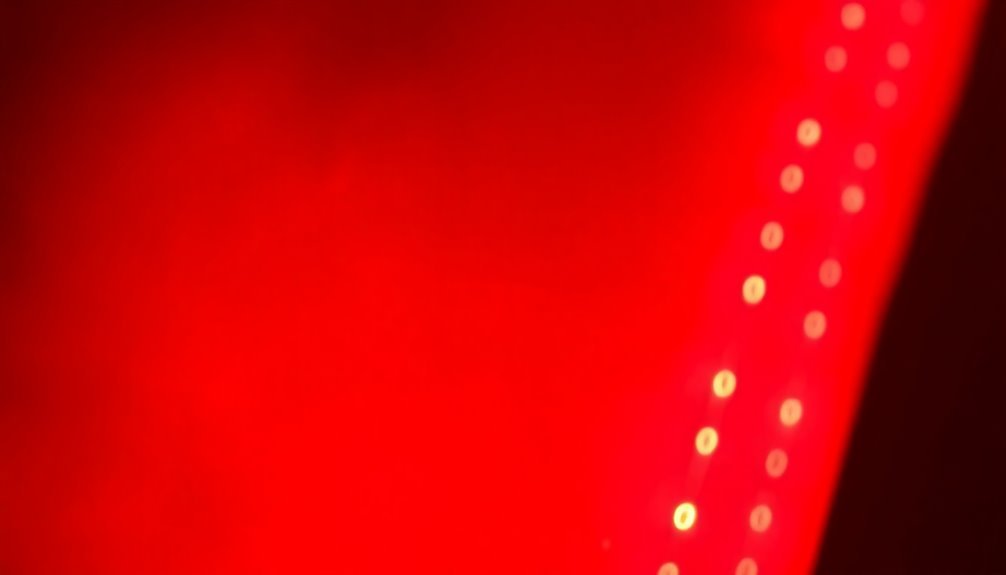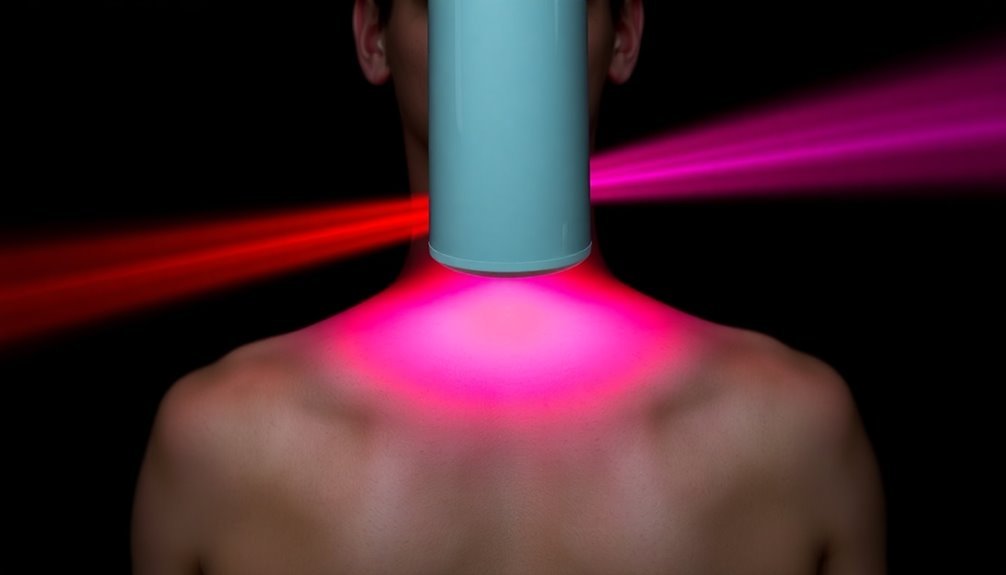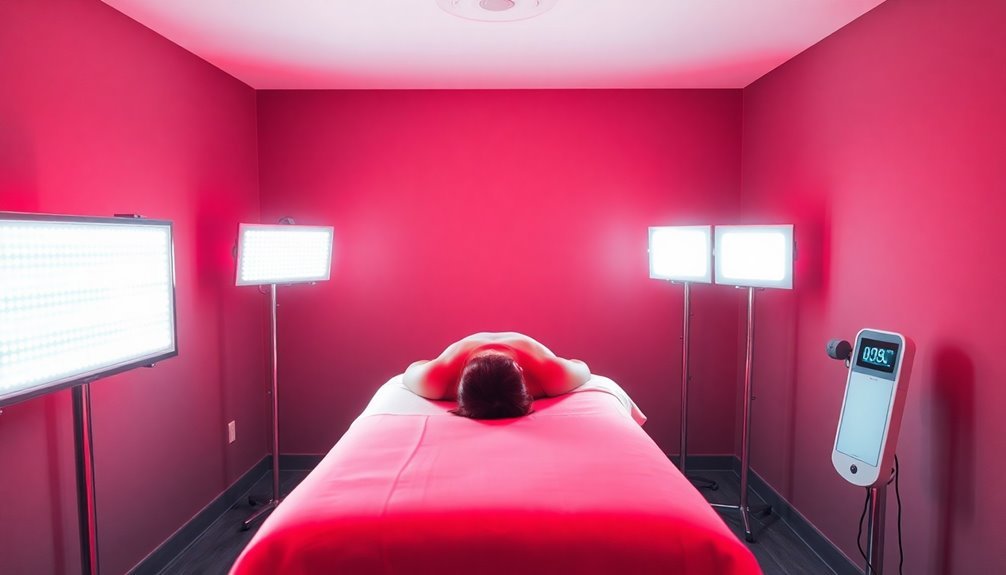Your best options for boosting cellular energy production through light therapy include red light (630-660nm), near-infrared (810nm), and combination red/NIR devices. Red light penetrates 1-2mm deep, targeting surface-level cells and enhancing mitochondrial function. Near-infrared light reaches up to 25mm, stimulating deep tissue energy production and cellular repair. Combination therapy delivers both wavelengths simultaneously, creating a synergistic effect that maximizes ATP production at multiple tissue depths. The key lies in choosing the right wavelength mix for your specific needs, and understanding how these therapies work together can reveal their full potential.
Red Light Depth Absorption

Light waves behave differently when they enter your body, and red light therapy harnesses specific wavelengths between 600nm to 900nm for ideal therapeutic effects. When you're exposed to these wavelengths, they target cytochrome C oxidase in your cells' mitochondria, boosting energy production. Light intensity levels directly influence therapeutic outcomes.
You'll find two main types of therapeutic light: red light (600-700nm) and near-infrared (700-900nm). While red light penetrates 1-2mm into your skin, near-infrared reaches much deeper, up to 25mm into your subcutaneous tissue.
The longer wavelengths of near-infrared light make it more effective for treating deep tissue conditions, while red light works better for surface-level concerns like skin rejuvenation and wound healing.
Your body's response to these wavelengths varies by intensity and specific wavelength. The most effective wavelengths are 630nm, 660nm, and 810nm, with 810nm providing the deepest penetration.
When you use red light therapy, about 80% of the energy is absorbed in the first 2cm of tissue. This absorption stimulates cellular activity, leading to improved circulation and reduced inflammation, even in areas not directly exposed to the light.
Near-Infrared Spectrum Benefits
Building on the depth penetration capabilities of near-infrared light, its spectrum offers remarkable benefits for your body at multiple levels. When near-infrared light reaches your cells, it boosts ATP production and enhances cellular respiration by breaking up excess nitric oxide that can interfere with oxygen utilization. Over 50% of solar radiation contains this beneficial infrared spectrum, though it's commonly lacking in indoor environments.
You'll experience improvements in both internal and external health. Your skin will show enhanced collagen production, reduced wrinkles, and better texture, while wounds heal faster due to increased white blood cell production and enzyme activity. The therapy's ability to reduce inflammation supports overall wellness and accelerates recovery.
Your mental health can improve considerably with near-infrared exposure. You'll likely notice enhanced cognitive function, reduced symptoms of depression and anxiety, and better overall brain health due to increased oxygen flow and improved neuroplasticity. The light's ability to stimulate biochemical processes helps maintain ideal brain function.
For physical health, you'll benefit from improved thyroid function, especially if you have conditions like Hashimoto's thyroiditis. Your muscles will recover faster after exercise, and you'll experience less pain due to the light's ability to promote cellular repair and reduce inflammation.
Combination Red NIR Therapy

When combined, red and near-infrared light therapies create a powerful synergistic effect that enhances your body's energy production at multiple cellular levels. This combination therapy works by simultaneously targeting different tissue depths, with red light penetrating the skin's surface layers while NIR reaches deeper into muscles and joints.
The dual-spectrum approach maximizes your cellular energy production through several key mechanisms:
- Your mitochondria become more efficient at producing ATP, as both wavelengths enhance the electron transport chain while reducing nitric oxide interference.
- You'll experience improved cellular respiration and reduced oxidative stress, leading to better overall cellular function. The decrease in water viscosity within cells helps optimize mitochondrial performance.
- Your body's natural healing processes accelerate through increased collagen production and reduced inflammation.
- You'll notice faster muscle recovery and reduced joint pain due to the therapy's deep-penetrating anti-inflammatory effects.
This combination therapy doesn't expose you to harmful UV rays or heat damage, making it a safe option for regular use.
Whether you're using a professional device or a home unit like Joovv, you'll benefit from both wavelengths working together to optimize your cellular health and energy production.
You can even combine this therapy with other treatments like hyperbaric oxygen for enhanced results.
Frequently Asked Questions
How Long Does It Take to Notice Increased Energy Levels From Light Therapy?
You'll typically notice increased energy levels within a few weeks of starting light therapy sessions. With consistent use, some people experience improvements after just a few sessions, with peak effects 3-6 hours post-treatment.
Can Light Therapy Sessions Be Combined With Other Energy-Boosting Treatments?
Yes, you can combine light therapy with exercise, supplements, massage, and other treatments to enhance energy production. You'll get better results when you pair it with activities that boost mitochondrial function and cellular health.
Does Medication Affect the Cellular Response to Light Therapy Treatments?
Yes, your medications can impact how your cells respond to light therapy. They may affect ATP production, alter light absorption patterns, and influence oxidative stress levels. It's important to discuss treatments with your healthcare provider.
What Time of Day Is Most Effective for Light Therapy Sessions?
You'll get the most benefits from light therapy in the morning, as it helps regulate your circadian rhythm and boost alertness. However, you can still see positive results at different times throughout the day.
Are There Specific Dietary Recommendations to Enhance Light Therapy's Energy-Boosting Effects?
You'll enhance light therapy's benefits by consuming antioxidant-rich foods, vitamin D, CoQ10, and omega-3s. Stay hydrated, limit sugar, and consider supplements like magnesium and L-carnitine for ideal mitochondrial function and energy production.
In Summary
You'll maximize cellular energy production by choosing between red light, near-infrared, or combination therapy based on your needs. Red light works best for surface-level concerns, while NIR penetrates deeper into tissues. For full-body benefits, you can't go wrong with a combination device that offers both wavelengths. Start with short sessions and gradually increase exposure as your cells respond to the therapy.





Leave a Reply